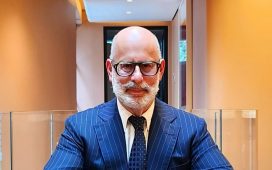Glynn Simmons had been in Oklahoma for six days when he was arrested on suspicion of robbery. He was 22, he didn’t have a criminal record and the police had no obvious reason to pick him up that day in 1975.
The robbery victim didn’t recognise him; Simmons was told he was free to leave. Just as he was about to be released, however, the police told him that they were short of men for a lineup and asked him to take part. Simmons didn’t know that it was within his rights to refuse. His mother had taught him the importance of respecting officialdom. So, dutifully, he took part. It cost him dearly.
Simmons was later charged with the murder of a 30-year-old liquor store worker, Carolyn Sue Rogers, who had been shot in the head during a separate robbery. Along with Don Roberts, he was convicted and sentenced to death, later reduced to life imprisonment. In July 2023, he was released, before being exonerated in September. In December, he was legally declared innocent of the crime. Simmons, now 70, had spent 48 years, five months and 13 days in prison – the longest time anyone in the US has been jailed before being cleared.
“You used the term miscarriage of justice,” Simmons says in his sonorous voice. “But what happened to me wasn’t a miscarriage of justice where they simply got it wrong. What happened to me was deliberate. There’s another title for that.” Is there a term he prefers? “Yes. Attempted murder.” Simmons says it is attempted murder because the police knew he would receive the death penalty if found guilty.
We are talking on a video call. Simmons is a handsome man with an easy smile that belies his horrific experience. He talks with warmth about his childhood as one of 13 kids in a close family in Louisiana. Simmons tells me he was a poor student and dropped out of school at 14. By 22, he and his partner had a three-year-old son, Glen. At this point, Simmons moved from New Orleans to Oklahoma for work.
He says you have to understand the mood in Oklahoma City to begin to make sense of what happened to him. It was a place seething with racism and injustice. It also happened to be a time when a series of serious crimes had gone unsolved and the police were coming under pressure from the press.
In February 1975, the bodies of two men were found in a rural area near Oklahoma City. A man called Leonard Patterson was arrested in connection with the murders, alongside his brother. After it emerged that the brothers had attended a party at the home of a woman called Dorothy Norris a few weeks earlier, the police rounded up everyone who had been at the party and put them in lineups. They were looking for witnesses who might have information on the Pattersons (Leonard Patterson later confessed to the murders), as well as suspects in other unsolved crimes.
Norris was Simmons’ aunt and he had been staying with her. He was arrested and placed in a lineup. As far as he is concerned, the police were on a fishing expedition, trying to attach names – any names – to crimes to boost their clearance rate. Soon enough, his name was attached to the murder of Rogers.
Told that he had been identified in the case, Simmons assumed it was a mistake that would quickly be rectified. After all, the police were there to uphold the law, not to abuse it. But then he was charged. Again, he assumed he would be cleared, because he hadn’t even been in Oklahoma at the time. Rogers had been killed on 30 December 1974; Simmons had flown from Louisiana to Oklahoma on 5 January 1975. Twelve witnesses testified that they had seen him on the day of the murder in Harvey, Louisiana; a number of them said they saw him playing pool in the evening, when the killing took place.
At the preliminary hearing, the prosecution brought forward 18-year-old Belinda Brown as an identification witness. A customer at the liquor store, she had been shot in the head during the incident. When interviewed after coming out of hospital, she told the late Det Sgt Anthony Garrett, one of two investigating officers, “my mind is all jumbled up” because of the brain injury she had suffered. This was not disclosed to the defence. At the trial, Brown identified Roberts as the shooter and Simmons as his accomplice.
A one-page document, separate from her other evidence, appeared to show that Brown had identified Simmons and Roberts during a lineup. “Those are the two guys I identified in the lineup and I identify them again now,” she told the court. But it later emerged that she had never identified them in the lineup. Lawyers for Simmons suggest that the one-page report was fabricated.
The trial was done and dusted in fewer than three days: “That’s including picking the jury and the deliberation!” Right until the verdict, Simmons assumed he would walk free. “Even when the head of the jury said I was guilty, I thought he was talking about somebody else. I thought: ‘This guy’s in trouble, whoever he’s talking about,’ till he mentioned my name. Then it dawned on me that he was talking about me.”
What was the make-up of the jury? “All white. One black guy was on the panel and he was immediately dismissed,” says Simmons. The thing he remembers most strongly is the reaction of his mother, who died 12 years ago. “She screamed. A piercing scream. She knew I was innocent. That’s what I still haven’t got over today. That scream.” Was she a good mum? “The best. The best ever.”
Thirty days later, in June 1975, he returned to court for sentencing. “I was sentenced to die by electrocution on 7 October.” How did he feel? “I cried. I was pissed off, confused. I ain’t got over it yet and it was 50 years ago.” It is not surprising. That Simmons is sane is an incredible achievement. But, he says, it wasn’t always that way.
On death row, he was locked in his cell, alone, for 24 hours a day. He was allowed out three times a week, for 15 minutes, to shower. “I’m locked in the cell with the electric chair right here.” He points down an imaginary corridor. “I’ve had mental health issues that haven’t been given a name yet. I went off the deep end a few times and have been temporarily insane a few times. It’s like a rubber band – it expands and it returns. But if it snaps, you don’t come back. I never snapped.” There were many who did, he says. “Some guys never did come back. Some guys lost it and took flight.”
He believes his periods of mental illness may have saved his life. “For me, it’s like taking a vacation from reality.” You make it sound lovely, I say. He rocks with laughter. “That’s what I’m trying to explain. It was a relief not to be so acutely aware of what happens every moment of the day. So when you go into this temporary insanity, it’s just you and your imaginary friends. And that makes you good for a little while, but you have to come back. You can’t stay long.”
How did it change him? “It made me grow up. It matured me real quick.” When he left school, he was semi-literate. After he was convicted, he received many supportive letters, but he didn’t know how to respond adequately. Meanwhile, the man in the neighbouring cell had started to pass on his own letters, asking Simmons to read them for him. “One day I snapped and said: ‘Man, can’t you read?’ He started crying and said: ‘No, man, but don’t tell anybody.’ He was embarrassed. I said: ‘Well, I can’t read that good either; what we can do is teach each other.’ And we did teach each other how to read and write, and I started writing legal briefs and cell stories and poems. Now, I’ve got certificates in literacy.”
He realised he had to teach himself law if there was to be any hope of securing his freedom. “You need to find new appeals, because that’s the only way you’ll get out. So I learned to write. Writing is fighting. And I learned to read. Reading is fleeing. You read a book and you escape.” He pauses. “And there was a lot of praying and a lot of crying.” Another pause. “And I smoked a lot of weed. It calmed me down.”
Simmons came from a religious Christian family who stood by him. “Lot of guys thought I came from a rich family, but I didn’t,” he says. “I come from an average poor family, like everybody else. But when I needed some money, I’d call my sister Margo and tell her to pass the plate. That’s how we generated money. They were passing it among the family – everybody put $10 in there, so I got a lot. If they sent me $100, at least $10 to $15 was going to some of these guys who don’t get nothing.”
Did his faith stop him being bitter? No, he says, he was plenty bitter. For a long time, he was a difficult prisoner. He saw no point in behaving. “I got damn rebellious. I was innocent. I didn’t feel I had to comply.” Was his non-compliance verbal or violent? “All of it in the early days. All of it. Riots and all kinds of stuff.”
There were times on death row when he considered taking his life – not because he was desperate, he says, but as an act of resistance. “I thought of suicide in terms of defiance. It’s not: I can’t handle it no more. No, I never came to that. I was just: before you come to kill me, I’m gonna kill myself.”
After two years, his sentence was commuted to life imprisonment. “So they let me off death row and put me back in the general population. I guess I was supposed to be extremely grateful that I wasn’t facing the death penalty no more. I didn’t feel no gratitude.”
By 1985, his behaviour had improved and he was placed in a minimum-security jail. He escaped. “The fence was two feet high and I just walked away. I was gone for three weeks. I was trying to cross into Mexico and I got busted on the border. They tried to give me a two-year sentence running concurrent with my life sentence, but I’m like: ‘Nope, let’s go to trial.’ So I went to trial and argued the confinement was illegal so the escape was justified.” He giggles. “But guess what? I lost. They gave me a five-year sentence.”
During his final 30 years in jail, Simmons says he calmed down. He was focused on clearing his name and helping others. “There’s a saying that hurt people hurt people. Sometimes it’s the opposite. Hurt people heal people. You can recognise the hurt and you can heal it. And I had been hurt so bad I could see it and hear it and feel it in other people.”
In 1995, the trial prosecutor, Robert Midfelt, wrote to the Oklahoma Pardon and Parole Board saying that the case had “troubled” him for 20 years because the evidence was so “thin”. One year later, a private investigator working for Simmons discovered a missing police report showing that Brown had initially stated that the man she identified as Simmons was 6ft tall and weighed about 200lb (91kg). Simmons was 5ft 8in and of a smaller build. It emerged that Brown had identified a number of witnesses from eight lineups, none of whom were Simmons.
It also emerged that, in Simmons’ lineup, Brown had identified number six as the suspect. Simmons was number two. He says: “I think the police said: ‘OK, we want Simmons – we already got the other guy.’” The “other guy” was the brother of Leonard Patterson, who later admitted he had been with his brother at the time of the double murder, but was never convicted. Despite all this, parole was repeatedly denied.
He would have been released years ago if he had been prepared to take the rap. “I got this term I call the burden of innocence versus the luxury of guilt. It would have been a luxury for me if I’d been guilty. I did time with guys who pleaded guilty for murder, rape, kidnapping, all kinds of atrocious crimes, and they do a certain amount of years and go before the Parole Board and say: ‘I feel remorse for what I did,’ and they give them parole and let them go. Every year, I went before the Parole Board and they turned me down because I claimed innocence. My innocence was my burden. That’s why I did 48 years in prison. You don’t see guilty guys do that kind of time in prison.”
Perhaps the most shocking thing about Simmons’s story is that he needed no new evidence to prove his innocence; it had been there all the time. He told the Tulsa-based lawyer Joe Norwood the same thing he had been telling other lawyers for decades; the only difference is that Norwood listened to him. When Simmons discovered that Brown had not named him in the initial lineup, he knew he should be a free man, because of a ruling that states convictions cannot be secured purely on the basis of courtroom identifications.
What’s more, he says, “when she did the photofit, none of it fitted me. That was never disclosed to the jury. In fact, it was deliberately suppressed. So whatever she said in court can’t stand no more. This is what I’d been trying to tell the lawyers, but they weren’t listening to me. I don’t have a law degree, I don’t speak the language. I’m just a li’l old convict in the penitentiary, so they would never listen to me.”
He was initially released last year as an “exoneree”, meaning that his conviction had been quashed because it was unsafe. (Black people are about 7.5 times more likely to be wrongfully convicted of murder in the US than white people, according to the National Registry of Exonerations.) Being exonerated wasn’t good enough for Simmons, though. So he continued to fight. “I’m not an exoneree – I’m actually innocent. There’s a difference.” Three months ago, he was declared innocent. Now, Norwood is determined to clear the name of Roberts, who was released on parole in 2008.
Just before his release, Simmons was diagnosed with stage four liver cancer. To add insult to injury, he was given no money to ease his rehabilitation into the community. People wrongfully convicted in Oklahoma are eligible for up to $175,000 in compensation. This would work out at a paltry $3,645 for every year Simmons was jailed. So far, though, he has received nothing. He relies on a GoFundMe campaign, which has raised nearly $350,000.
He is suing the police for compensation. Is it true that he is looking for $10m? No, he says. “I’m suing for hundreds of millions of dollars. The state hasn’t given me one dime. They haven’t even said they’re sorry. They haven’t said a word.”
Claude Shobert, a retired detective who worked under Garrett on the case and is named in Simmons’ lawsuit, told the Oklahoman newspaper that he remembers nothing about the murder, the lineups or the case. “After 49 years, it had to be something really special for me to remember, and since I don’t remember none of it, there’s nothing I can do about it,” he said.
Simmons is not interested in the money for money’s sake, he says – it would enable him to follow his dream. “It isn’t to buy me some big old luxurious ships or airplanes – I’m not into the material thing.” He hopes to use compensation to help people who have come out of prison to start a new life. “I want to give the guys that are coming out a wraparound support system. They need help or they’re going back in. That’s what I want to focus on.”
I ask how he is coping with the outside world. He grins the widest of grins. “Look at me! Look at me! You can tell. I’m so happy.” What is life like? “Life is beautiful, man. It’s so beautiful.” He tells me about the importance of his faith, his relationship with Glen, now 52, with whom he has been living, the exhilaration of driving for the first time in almost half a century.
I have talked to many people who have been wrongfully imprisoned and most are raging with anger, post-traumatic stress disorder or both. But Simmons is luminous with hope. He is even convinced he can beat cancer. “That’s receding, too. I came out of jail with stage four cancer. This thing’s down to stage two now.” He stops to take it all in. “Remarkable,” he says.










